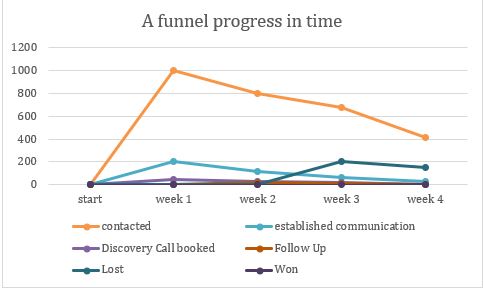B2B sales funnel essentials
The understanding on how a b2b sales funnel works is imperative on the preparation of a sales strategy and for the estimation and forecast creation on what to expect from a sales team, specifically in more complex b2b sales environments, where consultative sales is the main (if not the only) way on generating sales.
There is the belief that once you are going to start building a b2b sales funnel, more and more prospects are going to move up on the funnel, and therefore the conversion rate of the pipeline is going to increase with time.
That assumption is partly correct and the reason why that’s so, is because each communication stage of a prospect has its own dynamics.
But let us first see how a typical b2b sales funnel looks like from a direct sales perspective.
Let us say we have generated 1000 high-quality leads that are targeting our market of interest. That means that we have the contact details, email address, telephone nr of the prospects of interest.
WEEK 1
We contact all of them, either via email or via telephone and we manage to establish communication (that means to have a conversation or email exchange with the proper decision-maker), with 20% of them, that means that we manage to establish communication with 200.
Out of those 200, 25%, that means 50 of them are going to book a discovery call with us immediately or almost immediately.
The rest 150, 75% either required more information, or an evaluating our communication, or simply for other reasons cannot make a decision right now.
WEEK 2
From the 50 that booked a discovery call, 40 at the end attended the discovery call and half of them showed interest in our solution or product.
That means 20 are going to the follow-up stage.
From the contacted ones from last week (800 remaining in this stage) we manage to establish communication with 15% of them, which means 120. (Note that the conversion from contacted to establish communication drops, as out of those we call there are some that are not responsive at all. This percentage is going to decrease every week).
Out of those 120, 25% book a discovery call with us, which means 30.
Let’s assume the conversion rate is the same as last week. Then
WEEK 3
From the 30 that booked a discovery call, 24 at the end attended the discovery call and half of them showed interest.
That means 12 are going to go on the follow-up stage.
Now,
The contacted ones are now 680. From those we manage to establish communication with 10%, that means with 68, 25% book a discovery call, that is 17.
From the contacted ones we take out at the end of week 3, 200 and we close them as non-responsive, as they have been called +5 times the last 3 weeks.
The other 412 that stay are going to be contacted in week 4.
WEEK 4
From the 412 remaining on the contacted stage, we manage to establish communication with 7%, which means with 29, 25% book a discovery call, that is 7.
From those 7, 5 attend the call, and 3 show interest and go on the follow-up stage.
From the 383 remainings, 150 are closed as non-responsive as they have been called/emailed over 5 times.
From the 35 on the follow-up page, 3 buy or solution.
We continue with the remaining 233.

This paradigm takes certain assumptions.
First assumption is that all 1000 leads are going to be contacted the first week.
Normally that is not the case and its advisable not to be the case for a variety of reasons.
One reason is that by contacting leads in batches, first by sending an email and then by calling, there is a momentum and a reference between the email and the call. If you email them all in week 1, the person Nr. 1000 is going to probably receive the first call after 4 weeks, which does not make sense, since he has already forgotten the email sent.
One other reason is that you want to optimize during this process. By calling (or emailing) in batches you are going to be able to identify potential errors and optimize your process.
If you are going to contact the leads in waves, that is going to alter the above-mentioned graph, since it is going to bring every week new leads and new proportions on the scheme.
Second assumption is as you probably already noticed is that while we assume that the responsiveness of the contacted leads drops with time, we assume that the conversion rate from established communication to book a discovery call and show interest on that, remains the same. The reality is that there are going to be also deviations on that, however not as significant as the incremental non responsiveness of the contacted leads.
Third assumption is that the quality of the leads is identical, in terms of decision makers, industry, geography etc. There are probably hundreds of parameters that can potentially influence the flow of the diagram, the intention however of this example is to highlight the following.
Sales results are going to be increased with time as it takes a while to build a pipeline and mature a lead through all stages, UNDER THE CONDITION that new good quality potential leads are going to be added on the b2b sales funnel on a regular basis.


